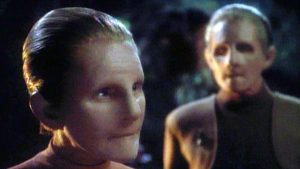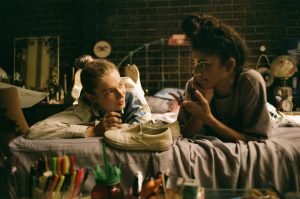
This article contains House of the Dragon spoilers through season 2 episode 4, “The Red Dragon and the Gold.”
Rhaenyra is doing everything in her power to avert breaking her father and grandfather’s peace. Alicent mistook Viserys’ dying words to be a plea for Aegon’s kingship. Aemond was just joshing with Lucerys and things got out of hand. For Rhaenyra, and now Jacaerys, this is not a war of dragons; it’s a distraction from the war against the next long night!
Each of these shifts in perception and twists on the “true story” behind George R.R. Martin’s elusive Targaryen history in Fire & Blood is clever. And they all speak to the larger thesis which House of the Dragon co-creator Ryan Condal and the whole writers’ room on the series are striving toward: wars and the sweep of history are not always—or even often—crafted by ingenious statesmen or ruthless tacticians. They can amount to a tragic comedy of errors, where bumbling mishaps, prejudices, and incompetencies snowball into grievances and animosities as inexplicable as the hatreds between the Blackwoods and Brackens—two ancient houses that have long forgotten the root cause for their tribal blood feud.
For every Tywin Lannister, who in Game of Thrones and its source material masterfully orchestrated the Red Wedding in malevolent obscurity, there are numerous Aegon IIs: vainglorious, foolhardy, and somewhat dim monarchs who rush into war and get themselves roasted to a toasty crisp. Hence HotD’s cruel choice to reveal the murder that made war inescapable—the death of young Lucerys at the end of season one—occurred because of some immature prank. There is also the heartbreaking realization that King Viserys’ painfully deluded conciliatory nature was born out of a fear of the family being divided against the coming White Walker storm. Often the true motives and psychological justifications for historic figures’ actions evade modern historians—never mind those in a medieval context where they also worked as proverbial propagandists. It’s all an admirably subversive interpretation of the material.
Nonetheless, halfway through House of the Dragon’s second season and on the other side of the Dance of the Dragons’ first bloodbath, it seems apropos to wonder if as a whole, this subversion of expectation is leading to somewhat diminished returns.
In the still fairly spectacular House of the Dragon season 2 episode 4, Emma D’Arcy’s Queen Rhaenyra Targaryen returns from her failed entreaty with Queen Alicent (Olivia Cooke) to inform her small council that she still hoped to preserve her father’s peace even after blood, including her son’s blood, had been spilled. This magnanimity reveals remarkable restraint and sober-thinking, considering Rhaenyra is grieving the death of her adolescent son. It even seems to ignore the last shot of House of the Dragon’s first season where Rhaenyra’s despairing countenance promised what book readers long anticipated from the Black Queen: a final straw snapping and a demand for fire and blood.
Those are, after all, her house words and even the title of the source material House of the Dragon is based on. Written as a faux-historical tome within the world of A Song of Ice and Fire, George R.R. Martin’s Fire & Blood recounts the Dance of the Dragons (along with many other eras during the Targaryen Dynasty) with tragic anguish and faint skepticism. Both the literary Rhaenyra and the literary Aegon II appear ultimately shortsighted and prone to the fallibility and sorrow that comes with giving mere mortals the absolute power and immunity of a monarch—more or less the central thesis to everything Martin writes.
Admittedly, the literary Rhaenyra’s persona is crafted by a fictional writer (Archmaester Gyldayn) who is sympathetic to the Greens’ claim. So the discerning reader should always keep a critical eye toward what is being presented on the page. Even so, Rhaenyra’s unavoidable humanness makes her susceptible to the same rushed thinking we can all experience under extreme stress—stresses like losing a child or having your inheritance stolen because you were born a woman.
The show’s Rhaneyra, however, behaves very much like the right-footed hero most 21st century viewers would hope to see in such a scenario: she has forbearance, empathy, and a startling degree of compassion for her enemy, just as she fears what the toll of destroying them might wreck on both their family and their subjects. There is of course a clever element in the series which explains this (and which Fire & Blood’s maester-author would never know about): Paddy Considine’s Viserys II told young Rhaenyra in the first episode of the series that Aegon the Conqueror had a vision which suggested dragons were needed to stop the coming of eternal night. It is the Song of Ice and Fire.
“That’s something that came from George,” Condal told us in 2022. “… [Aegon’s] remembered as a conqueror but he really meant to be a uniter.” Evidently, Martin always intended there to be motives and rationalizations that even his most devoted readers aren’t privy to.
This certainly gives House of the Dragon a lot of latitude to go its own way in telling this story however it sees fit. And as a reader who is definitely on the Team Black side of the equation, seeing Rhaenyra depicted as so morally clear-eyed is satisfying… yet she is not the only one whose motives are being cleansed and her alleged historical mistakes whitewashed.
Similarly, Queen Alicent, who definitely on the page was complicit in planning to put her son on the throne, is depicted as completely unaware of her father’s duplicity in orchestrating a palace coup after the king’s death. In fact, she doesn’t see it as a coup at all, but rather as dutifully carrying on the king’s last wish. Meanwhile her second son, who might be the closest the Dance of the Dragons has to a chaotic presence worthy of Game of Thrones’ rogue’s gallery, is revealed to initially be merely an incompetent kid who seems to genuinely mourn accidentally killing his young cousin.
Cumulatively, House of the Dragon’s desire to add nuance and moral complexity to all its characters robs them of a certain level of agency in their own choices—choices Martin intended to heighten the totality and tragedy of the war. Ewan Mitchell’s Aemond didn’t kill Lucerys; his dragon did. Alicent didn’t usurp her step-daughter, but thought she carried on the last wishes of her husband and king; and Rhaenyra neither had anything to do with Blood and Cheese or even the war. She begged Alicent to end the war last week, before sending dragons into battle this one.
The parler between the two queens at the end of the third episode strained a particular credulity, too. Yes, it allowed two powerhouse actors we love seeing on screen together—D’Arcy and Cooke—to finally share a scene in season 2. But like many other TV shows, it is bending logic to a breaking point in order to make that scene happen. One might suppose it even does suggest poor instincts for a leader to walk alone into her enemy’s capital in order to have a discussion that is doomed to failure before it begins.
The scene belatedly allows Alicent to take ownership of her ambitions since the Queen Mother at last realizes her mistake regarding Viserys’ final words, although even then the series hedges its bets. After saying “it’s too late,” Alicent then begs Rhaenyra to hide her face and leave the city before her guards find her. If Alicent really decided to double down on Aegon’s succession, come hell or high-water, she could end the war right there by calling her guards to arrest the “false queen.”
In order to let every character be always sympathetic to the viewers, no one outside perhaps Ser Otto Hightower (Rhys Ifans) and Prince Daemon (Matt Smith) are allowed to indulge in acts of premeditated malice.
… The good news, then, is that this might be changing after Rook’s Rest. Because at the end of season 2’s halfway mark, not only did we get the brutal battle of Rook’s Rest where the great Princess Rhaenys (Eve Best) was smited by her daughter’s own dragon… but we saw Prince Aemond do something that also wasn’t recorded by the history books: he attempted to murder his own brother.
According to Fire & Blood, the young king and his handsome dragon’s awful injuries were incurred by Meleys, Princess Rhaenys’ dragon. But in the series we learn that while Aegon would probably have lost that “dance” with Meleys, Sunfyre and the king were catastrophically maimed not by an aunt but by a brother who was supposedly there to support the king. Instead Aemond outdoes even Daemon and tries to usurp the throne through coldblooded kinslaying.
It frankly is a nastier and more villainous action than killing the young cousin who took his eye many years before. This, by contrast, is attempted regicide and a betrayal of literal brotherhood. It suggests the gloves are finally coming off, and the Targaryens are about to become as petty and self-absorbed as their literary counterparts always were. If so, the dance will finally find its rhythm.
The post House of the Dragon Needs to Let Rhaenyra and Alicent Not Be the Heroes of Their Own Story appeared first on Den of Geek.







